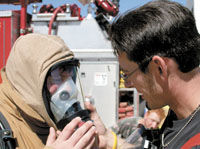| East Carbon City firefighter DJ Valdez secures an SCBA unit to Sun Advocate reporter Charles McManus. Both individuals took part in the controlled flashover training at the Carbon County Fairgrounds. Temperatures within the simulation reached as high as 900 degrees during the burn. |
On June 9, local firefighters received intensive hands-on flashover training.
According to Weber Fire Capt. John Meeks, the training could save the lives of emergency personnel.
Emergency crews from the East Carbon, Wellington, Helper and Price departments received one hour of classroom training prior to a practical demonstration of the rapid fire phenomena within a specialized mobile training environment at the Carbon County Fairgrounds.
“We lose firefighters to flashover every year, ” said Meeks. “We provide this training to show these brave men and women how to detect flashover conditions so they can recognize the situation early enough to get out safe,” explained the Weber District fire captain.
According to literature, flashover is difficult to define but is characterized by heat induced development of a compartment fire.
However, flashover can be intensified or even initiated by added or sudden ventilation.
Meeks reports that during flashover conditions temperatures within a given area can reach anywhere from 1000 to 1600 degrees with all surfaces free burning with open flame.
“I have seen fire burn the turn-outs right off a firefighter,” stated Meeks. “That is the most important part of this training, learning to recognize the warning signs of flashover early enough to get yourself out,” continued Meeks
During the one-hour lecture Meeks explained that firefighters face many difficulties within an open blaze including: threat of flashover, hazardous search and rescue, occupant survival and possible structure collapse.
“I know everyone here wants to be the hero when it comes to saving someone within a fire but it is imperative that you remember, no one ever rises to the occasion, you only fall to the level of your training,” explained the visiting instructor.
| Smoke billows from the Utah Fire and Rescue Academy flashover training simulator. Thick smoke is one of the early warning signs of an impending flashover. |
Meeks reported that changes in building materials and energy conservation efforts have made many building structures more dangerous for firefighters.
According to the Weber fire chief, building materials made from synthetic products such as plastics give off a much higher British thermal unit than conventional wooden building materials.
One pound of plastic gives off 18,000 BTUs, whereas a pound of wood will only give off 8000 BTUs.
“Firefighters these days just have to deal with a lot more hydrocarbons,” stated Meeks.
Similarly, homes are now wrapped in insulating material with triple paned windows making homes and other buildings insulate heat to a much greater degree.
With these circumstances, Meeks stressed that firefighters should watch carefully for the following signs:
•Intense radiant heat.
•Thick black smoke.
•Rollover, characterized by flames and smoke flowing like a river on the ceiling of the structure.
•Free burning, of all materials in the structure.
•Snakes, independent pockets of burning gas away from the fire source.
To combat these conditions long enough to escape Meeks instructed the firefighters to “pencil” the walls of the home with the hoses, decreasing the temperature of the surface area long enough to get out.
“I would like to remind everyone that this is a controlled training simulation where we get the chance to learn about our gear, to learn how we respond physically and mentally to the stress of the heat and to study fire and smoke behavior,” pointed out the visiting instructor.
“Our gear is rated for 1200 degrees for 12 seconds, so if you were to see a snake in an actual situation get out, because you are literally seconds away from not getting out at all,” cautioned Meeks.
At the county fairgrounds, firefighters loaded broken pallets into a two tiered container structure.
Within the container firefighters have the opportunity to sit below the seat of the fire in a space that would not exist within an actual burn.
Because the emergency crew members are positioned below the fire, they have the possibility to witness firsthand the smoke and the behavior of the flashover under somewhat decreased temperatures.
The fire is stoked and strategically vented within the container in order to initiate the flashover training conditions.
During the first training session, Meeks was able to produce flashover behavior six separate times, rotating the firefighters within, giving each the opportunity to have a front row seat to the volatile phenomena.
“The river of fire above our head, coupled with the intense heat was an amazing experience,” said East Carbon City firefighter DJ Valdez. “This is the most intense training we have gone through so far.”
Valdez and his brother, Cody, are part of a group that is taking simultaneous firefighter one and two training.
The Helper City Fire Department is sponsoring the training for the local fire fighers.
“If this training saves one person it is worth doing a thousand times,” concluded Meeks.

